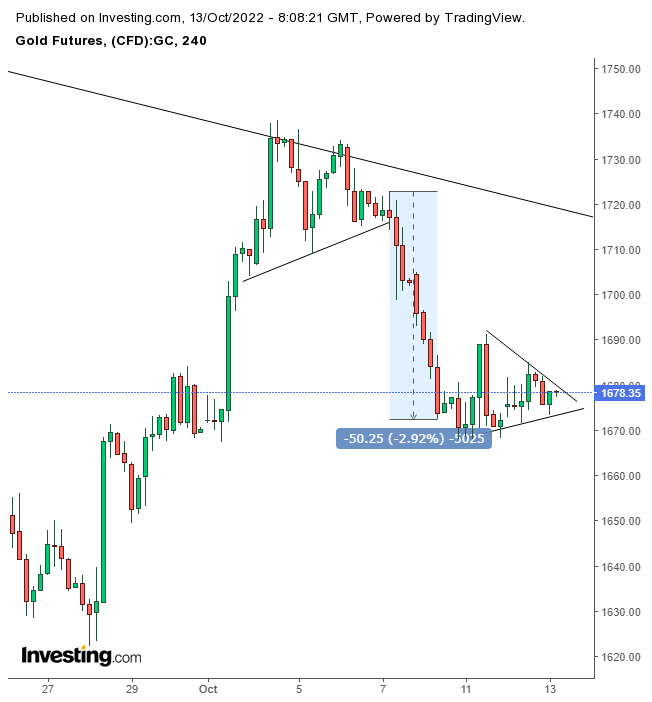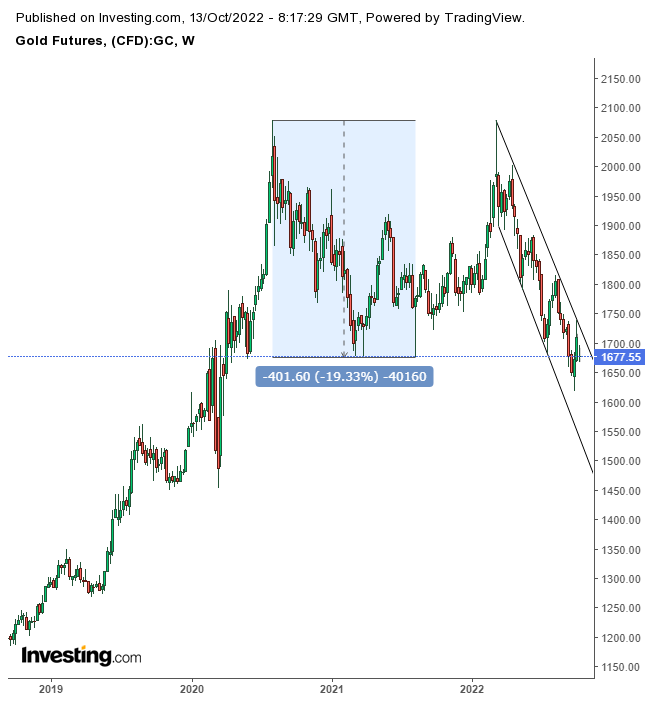The dollar is hovering near 20-year highs ahead of tdoay's US CPI release, which the Federal Reserve may respond to with a fourth consecutive jumbo interest rate hike.
James Ashley, head of international market strategy at Goldman Sachs said on Bloomberg Television that "the Fed is not going to blink." Adding, "if they're going to make a mistake, they would far rather err on the side of being too hawkish."
The ever-rising interest rate is siphoning investors away from non-yielding gold.

The 4-hour pennant's downside breakout will signal a resumption of the selloff within the falling channel.
Here are the presumed drivers of the continuation pattern.
Short sellers are locking in profits after eight straight 4-hour session plunges. The preceding H&S top or reversal triangle—the difference is academic—triggered a selloff that caused bears' hearts to skip a beat. Sellers added to demand when covering shorts, while ongoing selling by either new or short sellers with stronger convictions keeps the price from rebounding. If supply continues once short sellers complete covering, gold will fall below the pattern. This downside breakout will signal interest to all—ex and current bears, wounded bulls, and undecided—order flows will push the price down another leg.
The preceding pattern developed at the falling channel's top, confirming its marked medium-term downtrend since the Mar. 7, $2,078.70 all-time high. Gold has been negatively correlated to rising yields, following the Fed's persistent tightening, to the detriment of fund managers, like Ark's Cathie Wood.
Target Measuring
Short sellers disrupted the short-term downtrend since the channel top, as they were catching their breath after the dizzying selloff. Now that they have regained composure, the downside penetration will reverse fear back to greed, pulling them back in. Therefore, the previous selloff statistically repeats itself.
The series of red candles began at the $1,722 high, ending $50 lower at $1,672. Therefore, traders expect another $50 fall from the pennant's breakout point, aiming at around $1,625, retesting a much larger potential bearish pattern.

Last month, gold fell below its 2021 lows, which were also the lows between the two record peaks of 2020 and this year. In other words, the yellow metal completed a massive double top.
Last week, the price rebounded above the neckline. However, as I outlined, the price failed to hold onto gains and is back down at the neckline levels.
Gold will reinforce the double-top outlook if the price falls below its Sept. 28, $1,618 low. Given that the pattern's height is $40, the breakout could test $1,300, as all the invested interest within the structure repeats itself with the previous floor turning into a ceiling. The length of time to achieve the double-top's target could be as little as six months, the length of time it took gold to fall each time it reached its record, and as long as two years, the time it took the pattern to develop.
Trading Strategies - Short
Conservative traders should wait for the price to close below the pennant's $1,667.90 low, which would include at least three 4-hour candles to remain below the pattern, then for a return move that retests its integrity.
Moderate traders would be content with a close below $1,670 and two 4-hour candles to remain below the range, then for a throwback for a closer entry, if not for trend confirmation.
Aggressive traders could short upon the first close below the pattern.
Aggressive Trade Sample
- Entry: $1,672
- Stop-Loss: $1,682
- Risk: $10
- Target: $1,632
- Reward: $40
- Risk-Reward Ratio: 1:4
Disclaimer: The author has no positions in any securities mentioned in this article.
